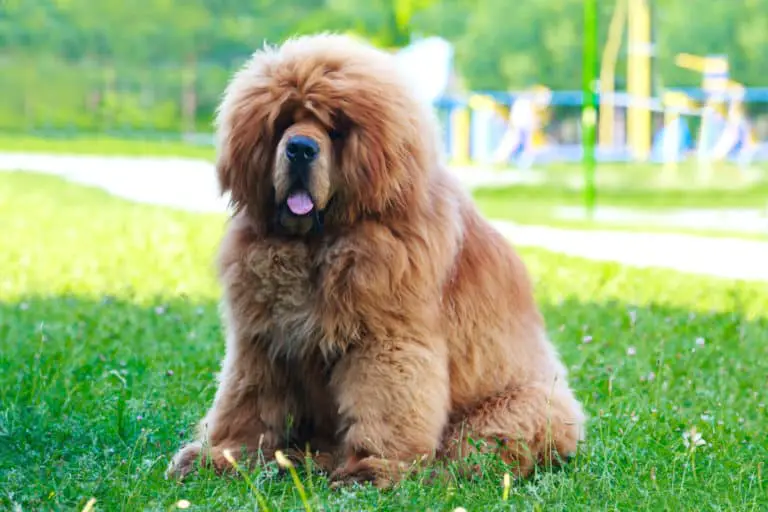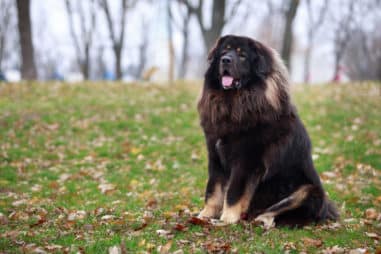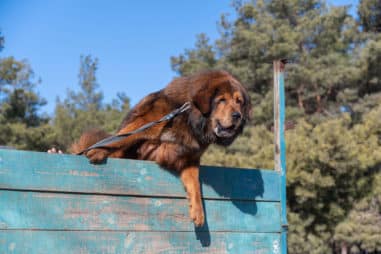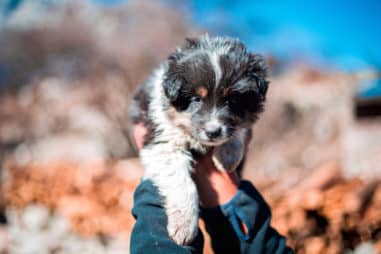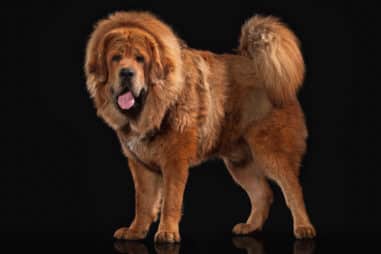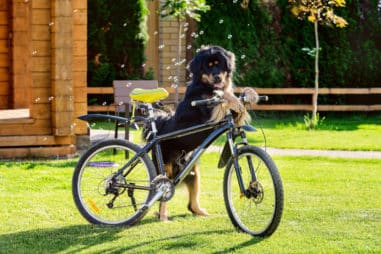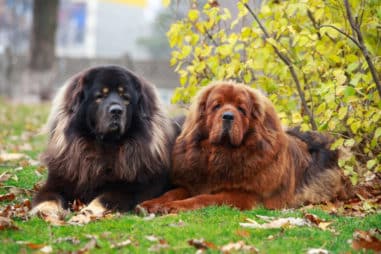Allergy is one of the primary concerns of dog lovers out there. Some people get allergic reactions when they come in contact with canines. You’re probably wondering if a Tibetan Mastiff is a good addition to your family.
If you’re a first-time dog owner, Tibetan Mastiffs may not be the right breed for you. For experienced owners, however, some precautions must be taken as well. Your family’s health history will be the basis for the decision to own a Tibetan Mastiff.
Do Tibetan Mastiffs Have Fur or Hair?
Fur and hair are the same. In terms of canines including the Tibetan Mastiff, it is usually referred to as fur. When the growth around a mammal’s body is coarse and sparse, it is called hair.
Tibetan Mastiffs are covered with fur and have double coats. They’re considered the lions among other dog breeds. This association is due to their size, behavior, and mane similar to lions.
People are in awe when they see a Tibetan Mastiff. They are eye-catching. Without looking closely, one might mistake them for lions.
What Kind of Fur Does a Tibetan Mastiff Have?
Tibetan Mastiffs have a combination type of fur. They do have a coarse and thick topcoat and a soft, wooly undercoat. These characteristics have made their heads look similar to lions.
In China, they’re being shown as status symbols. The rich families walk with them as a display of power and wealth. This is partly a reason why they have become so expensive.
The colors of their coats are usually black, brown, and gray. Breeding can affect the color or shades of their fur. They shed to replace old and damaged hair or to adapt to the season.
How Long Will My Tibetan Mastiff Fur Grow?
Tibetan Mastiffs’ fur can grow from short to medium length. Their coats look thick because they have double coats. The coats become thicker during winter to protect them from the freezing temperature.
When spring comes around, they will start to shed. During this time, the coats may look thinner because of the shedding. They’ll need some grooming when this happens.
Tibetan Mastiffs don’t shed as much compared to other dogs. But a good grooming plan will save you from a big mess inside your home. You don’t want hair floating or lying around the living room, do you?
What Type of Coat Does a Tibetan Mastiff Have?
A Tibetan Mastiff has a double coat. The topcoat is coarse and straight while the undercoat is soft and wooly. The undercoat is not instantly visible as it is covered by the topcoat.
The fur or hair on their head is fairly thick. This made people compare or even mistake them as lions. Your Mastiff will catch bystanders’ attention when you take him out.
Though they are large, the grooming won’t be much of a problem. The shedding happens only once or twice a year. These are considered seasonal sheds.
If your Mastiff is shedding excessively, they’ll need medical attention. The amount of hair can also trigger allergies in family members. Dogs are not recommended for people with asthma and allergies.
Does a Tibetan Mastiff Have a Double Coat?
While Greyhounds are single-coated dogs, Tibetan Mastiffs have double coats. The visible part is called the topcoat. The one covered by the topcoat is the undercoat.
The color of their coats may vary as well. The two are distinguishable by texture. Their topcoat is harder than the undercoat.
The double coat serves as protection from harsh elements. Winter is the time when their coats become thicker. They shed during warmer seasons so prepare for some frequent brushing.
Do Tibetan Mastiffs Have an Undercoat?
Some dogs are single-coated. Tibetan Mastiffs are double-coated dogs. The visible part is the topcoat and underneath it is the undercoat.
The undercoat is wooly and softer than the topcoat. Their topcoat is straight, coarse, and usually short in length. The coat adapts when the season is changing.
When Do Tibetan Mastiffs Get Their Full Coat?
The full or double coat will grow when a Tibetan Mastiff turns into an adult. Puppies are usually born with a single coat.
The season comes into play when a coat becomes full and thicker. They have thicker coats during cold seasons and shed during the warmer seasons. During the shedding season, they would need frequent brushing. This is to avoid a mess and any allergic reactions.
Is a Tibetan Mastiff Hypoallergenic?
Sadly, Tibetan Mastiffs are not hypoallergenic. Although their shedding is not frequent, they still need brushing during this period. They don’t need much trimming though because of the short length of their fur.
Regular brushing is advised during the warmer season to avoid the hairs from piling up. You can do the brushing at home or visit a dog salon for grooming. Make sure that you introduce your Tibetan Mastiff properly to avoid an ugly scenario. Some untrained Tibetan Mastiffs are not so friendly with strangers. You should keep this thing in mind when taking them outside.
How Much Do Tibetan Mastiffs Shed?
You don’t have to worry about a year-long brushing and cleaning. Tibetan Mastiffs don’t shed frequently. They only shed once or twice a year depending on the season.
They may not be hypoallergenic, but the shedding is not much of an issue. Just keep them away from family members who have allergic reactions to dogs. If they’re losing too much hair, consult your vet to diagnose health issues.
You also need to check their fur if there are fleas present. Parasites can cause hair damage and skin infections. Practicing good hygiene is your dog’s protection against parasites.
Do Tibetan Mastiff Puppies Shed a Lot?
Puppies are born with a single coat. A Tibetan Mastiff puppy will grow its double coat as time goes on. During its younger years, there’s not much shedding.
Adult Tibetan Mastiffs shed their undercoat yearly. The amount of shedding is lesser compared to other dogs. During the shedding season, regular brushing must be practiced.
When Do Tibetan Mastiffs Shed?
Tibetan Mastiffs do shed during the spring season and it’s called seasonal shedding. The thicker fur is sometimes called a winter coat. Their bodies will adjust to warmer temperatures through this process.
They lose hair from the undercoat as the temperature changes. You should brush their coat regularly during the seasonal shed. Once the process is complete, their coats won’t shed as much for the rest of the year
If your Tibetan Mastiff is scratching and shedding abnormally, take him to the clinic. This could be due to an infection from parasites or allergens. It’s also worth checking if your dog is shedding in an unusual season.
How Often Do Tibetan Mastiffs Shed?
Some dog breeds shed more than others. Tibetan Mastiffs don’t shed much fur and it only happens once or twice a year. They’re shedding goes with the season.
During the cold months, their fur or winter coat is thicker. The spring season will give way to the shedding of the undercoat.
The amount of shedding not only depends on the season. Your Tibetan Mastiff’s general health will come into play as well. Proper grooming and health care should not be taken for granted.
Your family’s safety is important too. Protect them from the allergies that can be caused by a Tibetan Mastiff’s seasonal shed.
Do Tibetan Mastiffs Get a Winter Coat?
Tibetan Mastiffs have weather-resistant coats. Their bodies can adapt to different types of climate. Their fur is thicker during winter to protect them from the freezing temperature.
Their thicker coat is referred to as the winter coat. Shedding of the winter coat happens at the beginning or middle of spring. If winter is approaching, the winter coat will start to grow.
The growth and shedding of their coats happen yearly. It is a cycle that goes on throughout a Tibetan Mastiff’s life. Consult your vet when the shedding happens at an alarming rate.
Why Is My Tibetan Mastiff Shedding So Much?
Shedding is a natural part of a dog’s life that is not hypoallergenic. Tibetan Mastiffs don’t shed a lot of fur. But sometimes they can shed their entire coat. If your Tibetan Mastiff is shedding his entire coat, you have to prepare tools for grooming.
Well, you’ve got a busy schedule and it coincided with the seasonal shed … this is when a pet groomer steps in. A pet groomer will take care of not just the shedding but the bathing and trimming as well.
When the shedding goes beyond the normal amount or period, you’ll need an appointment with your vet. The main culprits for this are fleas, lice, and mites. The bite from these parasites can lead to scratching, infection, and hair loss.
How Do I Stop My Tibetan Mastiff From Shedding
Good grooming and hygiene are keys to stopping the shedding problem. Brush the coat of your dog regularly and clean up the hair that fell out. Keep your home clean to avoid allergies and infections.
A weekly bath is also advised to keep your dog clean and safe from parasites. If you don’t have a grooming kit, a pet groomer can take care of that.
Checkups can’t be overlooked as excessive shedding might be a symptom of another issue.
It is possible to have a Tibetan Mastiff at your home despite allergy risks. You can counter allergic reactions with over-the-counter medications. These include decongestants and antihistamines. If you are taking other medications, consult a doctor first.
Grooming, diet, training, and healthcare are all vital in a dog’s life. Like humans, they also have needs that cannot be ignored. Keep your home clean and safe for your family and Tibetan Mastiff alike. The world is not as bleak when you have a happy and loyal doggo by your side.

